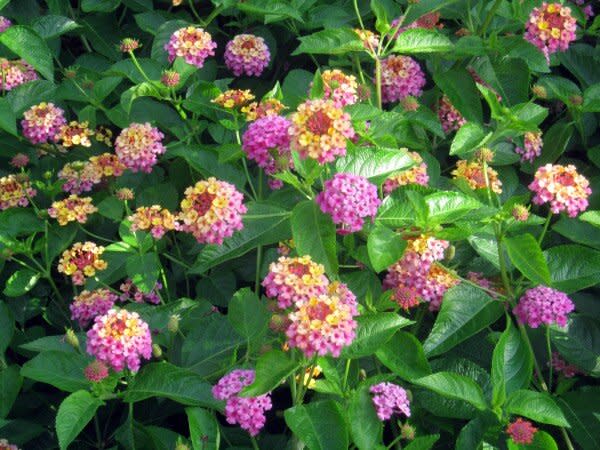10 Deer-Resistant Flowers for Sun

Getty Images
Gardeners and deer are not fast friends. Gardeners plant flowers. Deer gobble them. Exasperated victims wonder, "Are there any flowers that deer won't chomp?
Yes! Quite a few. This doesn't guarantee deer won't nibble occasionally. But by relying on the following flowers your entire garden won't be here today and gone tomorrow. All prefer a sunny spot.
Snapdragon
(Antirrhinum majus)
A cool-weather annual in the South and perennial up North, snapdragon gets its name from blossoms you can pinch shut like snapping jaws. Spectacular spikes of yellow, orange, pink, white, and red blooms stand 6 to 36 inches tall, depending on the selection. They make superb cut flowers, boon companions to pansies and violas, and really show off in window boxes and containers.

Angelonia
(Angelonia angustifolia)
Angelonia is sometimes called "summer snapdragon" for the snapdragon-like look of its flower spikes, but the similarity ends there. It loves heat. Combine that with sun and well-drained soil and you'll get nonstop blossoms of blue, purple, pink, red, or white from spring until fall. Plants range from 6 to 24 inches tall. Upright forms work well in borders. Use trailing types in hanging baskets and window boxes.

Poppies
(Papaver sp.)
This group of annuals and short-lived perennials provides a rainbow of bright colors in spring and summer. Like snapdragons, they perform better before the summer burn sets in. They also make good cut flowers, but sear the ends of the cut stems with a flame to make them last longer when placed in water. Poppies for sale now come in pots. If you wait until fall, you can sprinkle poppy seeds on the soil surface, let the rain water them in, and enjoy a raft of seedlings in spring.

Love-in-a-Mist
(Nigella damascena)
Prized for its lovely blue, pink, or white flowers as well as ornamental seed pods used in arrangements, this old-fashioned annual blooms in a "mist" of threadlike foliage. Plants grow 12 to 18 inches tall. Sow seeds directly into the garden in early spring and again in fall. Love-in-a-mist dies in the summer swelter, but will sprout the next spring if you either let the seed pods drop seeds on their own or save the seeds and sow in fall.

Globe Amaranth
(Gomphrena globosa)
Like angelonia, this tidy annual blooms nonstop from spring to fall. Rounded, cloverlike flower heads top plants ranging from 6 to 24 inches tall. Available colors include purple, red, orange, pink, and white. Established plants need little water and pests seldom bother them. Cut flowers are easy to dry and use in arrangements.

Lantana
(Lantana sp.)
Last summer, I drove through a deer-infested neighborhood. Lantana was the only thing blooming. Fortunately, lantana is something you'd want deer or no-deer. It takes heat and drought, has no serious pests, and bears showy, flattened flower clusters in colors or red, orange, yellow, pink, salmon, white, or lavender. Hummingbirds, butterflies, and other pollinators love it, but deer can't stand the stuff. Oh well, there's no accounting for taste! Height and spread vary by selection, but two feet tall and three feet wide is common.

Sweet Alyssum
(Lobularia maratima)
Few annuals do as good a job edging the front of a border as sweet alyssum. This trailing plant grows 6 to 12 inches tall and features honey-scented blooms of white, pink, or purple. It flowers from spring to fall, although blooms are sparser during the dog days of summer. Shear it back by half at this time to encourage new growth and flowers. White 'Snow Princess' keeps blooming even through hot summers.

Floss Flower
(Ageratum houstonianum)
This old-timey annual is one of your best sources for true blue in the garden. It also comes in pink, purple, and white. Plants form compact mounds 6 to 12 inches tall and wide covered with fuzzy blooms resembling powder puffs. Floss flower is good for cutting, attracting butterflies, edging the front of a bed, or growing in containers. It prefers, moist, well-drained, fertile soil.

Spider Flower
(Cleome hassleriana)
Also called grandfather's whiskers, spider flower gets its name from long stamens protruding from its open flowers. Flowers may be pink, rose, white, or purple. Some selections remain a single color, while others open purple, rose, or pink and fade to white the next day, giving you two colors on one plant. These fast, upright growers can grow five feet tall, a good size for the back of the border. If's that's too tall, try lavender-pink 'Senorita Rosalita' that tops out at 18 inches.

Salvia
(Salvia sp.)
Salvia is a tremendously large group of plants comprised of both annuals and perennials. Although a few wait to bloom until late summer or fall, most flower continuously in warm weather from late spring until frost, offering about every color there is. Butterflies and hummers love them. Give these plants heat, sun, and well-drained soil. Remove spent flowers to encourage the production of new ones.

